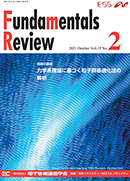Volume 15, Issue 2
Displaying 1-23 of 23 articles from this issue
- |<
- <
- 1
- >
- >|
Cover
-
2021Volume 15Issue 2 Pages 0
Published: October 01, 2021
Released on J-STAGE: October 01, 2021
Download PDF (374K)
Table of Contents
-
2021Volume 15Issue 2 Pages 67
Published: October 01, 2021
Released on J-STAGE: October 01, 2021
Download PDF (216K)
Preface
-
2021Volume 15Issue 2 Pages 68-69
Published: October 01, 2021
Released on J-STAGE: October 01, 2021
Download PDF (283K)
Origins of Technology
Proposed by Editorial Committee
-
2021Volume 15Issue 2 Pages 70-79
Published: October 01, 2021
Released on J-STAGE: October 01, 2021
Download PDF (1911K)
Review Papers
Proposed by BioX (Biometrics)
-
2021Volume 15Issue 2 Pages 80-87
Published: October 01, 2021
Released on J-STAGE: October 01, 2021
Download PDF (1610K)
Proposed by HWS (Hardware Security)
-
2021Volume 15Issue 2 Pages 88-100
Published: October 01, 2021
Released on J-STAGE: October 01, 2021
Download PDF (2534K)
Proposed by WBS (Wideband System)
-
2021Volume 15Issue 2 Pages 101-110
Published: October 01, 2021
Released on J-STAGE: October 01, 2021
Download PDF (4258K)
Proposed by SIS (Smart Info-Media Systems)
-
2021Volume 15Issue 2 Pages 111-120
Published: October 01, 2021
Released on J-STAGE: October 01, 2021
Download PDF (10911K)
Proposed by WBS (Wideband System)
-
2021Volume 15Issue 2 Pages 121-128
Published: October 01, 2021
Released on J-STAGE: October 01, 2021
Download PDF (3961K)
Miscellaneous Articles
ESS News
-
2021Volume 15Issue 2 Pages 129-132
Published: October 01, 2021
Released on J-STAGE: October 01, 2021
Download PDF (824K)
Let's go to IEICE Workshops!
-
2021Volume 15Issue 2 Pages 133
Published: October 01, 2021
Released on J-STAGE: October 01, 2021
Download PDF (203K) -
2021Volume 15Issue 2 Pages 133b-134
Published: October 01, 2021
Released on J-STAGE: October 01, 2021
Download PDF (273K) -
2021Volume 15Issue 2 Pages 134
Published: October 01, 2021
Released on J-STAGE: October 01, 2021
Download PDF (216K) -
2021Volume 15Issue 2 Pages 134b-135
Published: October 01, 2021
Released on J-STAGE: October 01, 2021
Download PDF (293K) -
2021Volume 15Issue 2 Pages 135
Published: October 01, 2021
Released on J-STAGE: October 01, 2021
Download PDF (223K) -
2021Volume 15Issue 2 Pages 135b-136
Published: October 01, 2021
Released on J-STAGE: October 01, 2021
Download PDF (290K) -
2021Volume 15Issue 2 Pages 136
Published: October 01, 2021
Released on J-STAGE: October 01, 2021
Download PDF (214K)
International Conference Report
-
2021Volume 15Issue 2 Pages 137
Published: October 01, 2021
Released on J-STAGE: October 01, 2021
Download PDF (124K) -
2021Volume 15Issue 2 Pages 138-139
Published: October 01, 2021
Released on J-STAGE: October 01, 2021
Download PDF (505K)
Winners' Voice
-
2021Volume 15Issue 2 Pages 140-142
Published: October 01, 2021
Released on J-STAGE: October 01, 2021
Download PDF (901K)
Call for Papers
-
2021Volume 15Issue 2 Pages 143
Published: October 01, 2021
Released on J-STAGE: October 01, 2021
Download PDF (438K) -
2021Volume 15Issue 2 Pages 144-146
Published: October 01, 2021
Released on J-STAGE: October 01, 2021
Download PDF (142K)
Committees & Editors Notes
-
2021Volume 15Issue 2 Pages 147-149
Published: October 01, 2021
Released on J-STAGE: October 01, 2021
Download PDF (331K)
- |<
- <
- 1
- >
- >|
